Tom does some long range shooting with the Sightmark 5-30×50 Pinnacle Riflescope off a Ruger Precision Rifle in this review.

During our testing, the Ruger Precision Rifle chambered in 6.5mm Creedmoor is proving to be one seriously accurate piece of equipment.
A sweet rifle like that wouldn’t be all that useful without an equally sweet optic purposely matched for long-range functionality. Enter the kind folks at Sightmark. They’ve contributed the 5-30×50 Pinnacle Riflescope you see here. So, if you’re the lucky winner, you’ll get both the Ruger Precision Rifle and this Sightmark optic to match. Not a bad deal, right? Let’s take a closer look at what the Sightmark 5-30×50 Pinnacle has to offer.
Sightmark 5-30×50 Pinnacle: The Specs
Let’s start with the basic stuff. This is a variable-power magnified optic that ranges from 5x to 30x. I’m normally a fan of less magnification rather than more. Still, for F-Class competition or other long-range use that gets to or exceeds four-digit territory, you’ll want 25x or more, assuming that the scope presents a clear and crisp image without distortion. At 1,000 yards, give or take, it’s supremely helpful to see where your impacts go, and with a 30x, you can do that depending on the target in use. Painted steel is a great example.
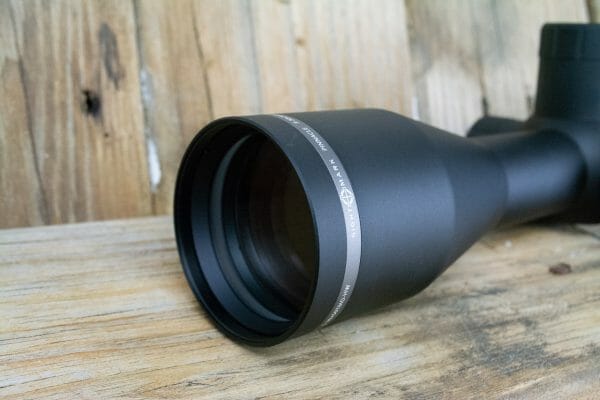
The main tube has a diameter of 34mm, so this scope is a beast, but I mean that in a loving and complimentary way. The objective lens is 50mm, so the exit pupil is a bit small at full magnification, so you’ll have a bit of eye placement sensitivity. Welcome to the price of big magnification. In a minute, we’ll talk more about the magnification sweet spot of this scope.
The Pinnacle has target turrets but with covers. Kind of a neat solution. I’d keep both covers on when transporting and only remove the top turret cover when shooting. I prefer to use the reticle for windage and lead rather than the windage turret, so at least for me, there’s not frequent need to adjust the windage turret once the rifle is zeroed. Speaking of turrets, they adjust in .1 mil per click increments, or just over one-third of an inch per click at 100 yards.
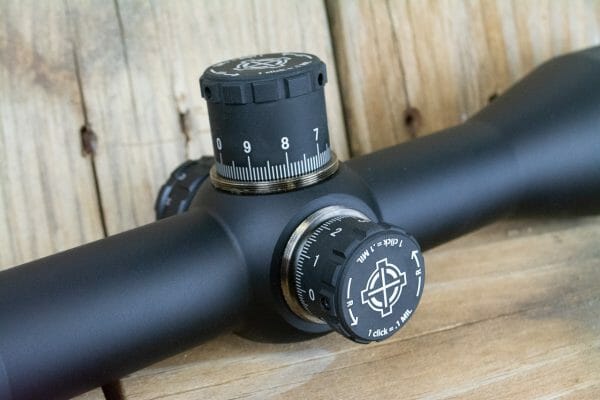
The magnification ring moves about 180 degrees from the 9 o’clock to the 3 o’clock position when moving from 5 to 30x magnification. There’s also a nub on the adjustment ring so you can mount a throw lever if you like. Even without a lever, that nub makes it easy to adjust the power level with your support hand. The ocular reticle focus wheel doesn’t lock but is easy to adjust. There’s enough friction that it’s unlikely to move out of focus on its own.
On the left is a dual-purpose parallax focus and reticle illumination dial. You can adjust parallax down to 30 yards and infinity the other way, although the last yardage marking is 500 yards.
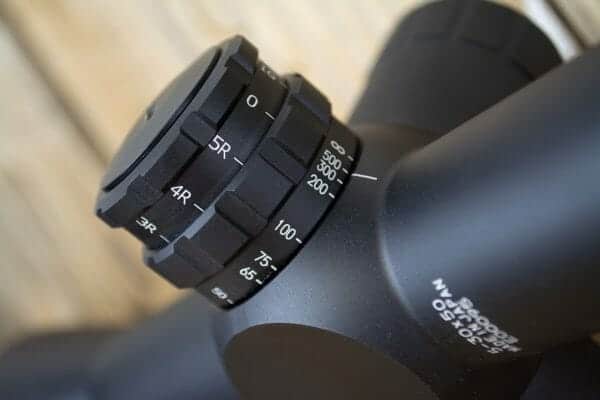
Zero Stop
The Sightmark 5-30×50 Pinnacle features a hard zero stop that you can adjust once you zero the rifle for your load and zero range. If you make a big elevation adjustment, you can return the elevation reticle to zero without looking by merely spinning the turret clockwise until it stops. That’s it. Here’s how it works.
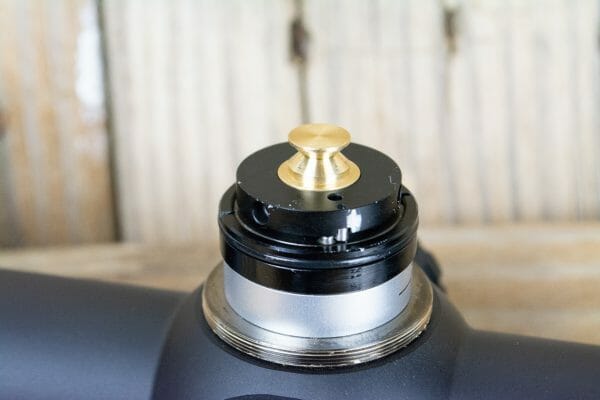
The elevation turret has three embedded hex screws. Loosen, but don’t remove them, and you can remove the turret cap. That exposes a locking ring that you can loosen and rotate freely. Once you have zeroed your rifle, adjust this ring so that the two mechanical stops touch. Then tighten the locking ring, reinstall the cap with “O” in the desired position, and tighten the embedded Allen screws in the cap. It’s a lot simpler than it sounds, and the manual has clear instructions and photos.
First Focal Plane Reticle Performance
As the Sightmark 5-30×50 Pinnacle riflescope uses a first focal plane reticle, the reticle grows in size as you increase magnification. With a big magnification scope like this, there’s a tradeoff to be made. How big should the reticle be in the viewfinder at the lowest and highest magnification settings? If you make it small at 5x, you’ll see more of it at 30x. If you make it larger at 5x, then more of it will be “lost” outside the viewable area at 30x. As a result, the manufacturer needs to make a tradeoff to efficiently use the reticle at the lowest and highest magnification levels and everywhere in between.

At the 5x setting, this Pinnacle TMD-HW reticle fills roughly one-third of the viewable area. There are heavy crosshairs outside of that – I’m just talking about the graduated section of the reticle that extends ten (10) mils in each direction from the center. When you move to 30x magnification, you can see just shy of 6 mils in each direction from center, so there’s your tradeoff.
I did find that the reticle is usable for holdover, even at the 5x setting. Even though it’s small, you can make out the hash marks due to the fine pattern of the reticle markings. At 8x and above, the reticle is large and clear enough for both holdover and ranging use with ease – and my eyes are old.
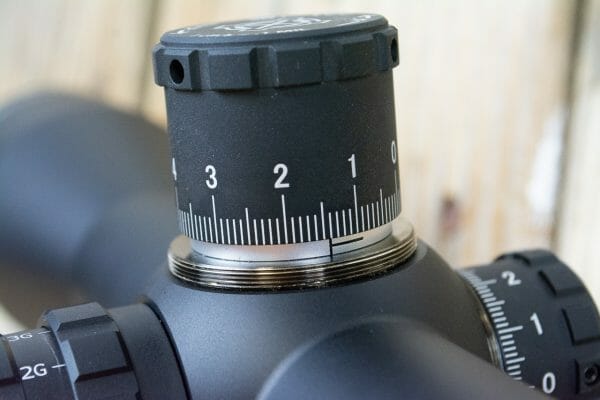
The graduated section of the reticle extends from edge to edge in the viewfinder at right about 16x magnification. In a way, this is kind of the sweet spot because you have the full view of 10 mils of reticle hashmarks in each direction right, left, and below the crosshairs.
Sightmark 5-30×50 Pinnacle Scope’s TMD-HW Reticle
In my opinion, this reticle offers a nice balance between full-featured and too busy. The primary hashmarks on the windage and elevation bars are in half-mile increments, and even numbers are printed to help you keep track of where you are. On the far right and upper segments, you will find that the areas between 7 and 10 mils are graduated in .2 mil increments. These areas help you “size” targets more precisely so you can better estimate range.

Live Inventory Price Checker

|
Sightmark 5 Power Magnifier - Sightmark 5x Tactical Magnifier Slide To Side | Brownells.com | $ 119.99 |
|
|
|
Sightmark 5-30x56 Presidio LR2 MRAD Illuminated 1/10 Mil Reticle FFP Rifle Scope - SM13142LR2 | Palmetto State Armory | $ 566.99 $ 489.99 |
|
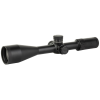
|
Sightmark 5-30x56 Presidio LR2 MRAD Illuminated 1/10 Mil Reticle FFP Rifle Scope - SM13142LR2 | Palmetto State Armory | $ 566.99 $ 489.99 |
|
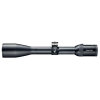
|
Swarovski Z6 5-30x50 BT 4W Riflescope Black 59918 | EuroOptic.com | $ 1799.99 |
|
Below the center crosshairs, you’ll see a Christmas tree pattern that allows you to hold over both windage and elevation with precision. Large dots on that tree (see the illustration above) are at 1 mil increments, while the small dots in between are also at .2 mil increments for more precise windage and lead adjustments. They also provide another handy target sizing scale.
The reticle is illuminated in both red and green, and each color offers five different intensity levels.
The bottom line is this. Whichever one of you wins this scope is going to be a happy camper. I hadn’t used any Sightmark gear before, and I am suitably impressed with this optic.
Sightmark 5-30×50 Pinnacle Specifications
| Reticle, Type | TMD-HW |
| Reticle, Color | Red/Green |
| Reticle, Illuminated | Yes |
| Setting, Brightness | 5 |
| Finish/Color | Matte black |
| Magnification | 5 – 30 x |
| Diameter, Objective Lens | 50 mm |
| Diameter, Eyepiece | 32.9 mm |
| Diameter, Exit Pupil | 8.8 – 1.7 mm |
| Eye Relief | 97 – 96 mm |
| Field of View | 6.7 – 1.1 m @100m |
| Field of View | 3.4 – 2.2 ft @100yd |
| Field of View | 3.86 – 0.64 degree |
| Diopter Adjustment | +2 to -2 |
| Diameter, Tube | 34 mm |
| Parallax Setting | 30 – ∞ yds |
| Windage Range of Adjustment | 18 MRAD |
| Elevation Range of Adjustment | 26 MRAD |
| MRAD Adjustment, 1 click | 0.1 MRAD |
| Travel Per Rotation | 10 MRAD |
| Maximum Recoil | 800 |
| Battery Type | CR2032 |
| Battery Life | Red: (high) 50 – (low) 2000 / Green: (high) 30 – (high) 800 hours |
| Battery Voltage | 3 V |
| Sunshade | yes |
| Nitrogen Purged | yes |
| Shockproof | yes |
| Fog Proof | yes |
| Focal Plane | 1st |
| IP Standard | IP67 (submergible to 1m) |
| Body Material | Aluminum |
| Material, Lens | glass |
| Lens Coating | Fully multi-coated |
| Operating Temp,�F/�C | -20 to 160 / -29 to 71 F/C |
| Length | 14 / 357 in/mm |
| Width | 3.65 / 92.9 in/mm |
| Height | 3.14 / 79.9 in/mm |
| Weight | 34.5 oz |
| MSRP | $1,799.99 |
About Tom McHale
Tom McHale is the author of the Practical Guides book series that guides new and experienced shooters alike in a fun, approachable, and practical way. His books are available in print and eBook format on Amazon. You can also find him on Facebook, Twitter, Instagram, and Pinterest.



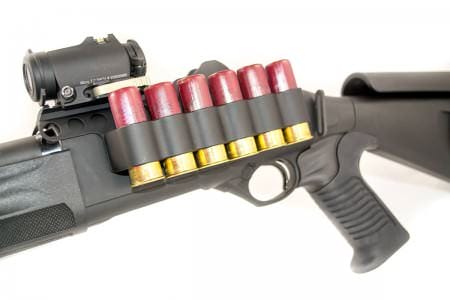
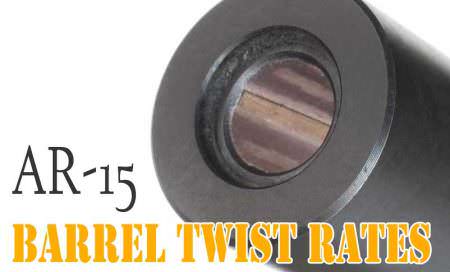

Oldmarine If this scope had both 1st AND 2nd focal plane then it would be a superior scope but there is only one scope on the market that does that. The Shepherd scopes hold the Patten on the double reticle scopes. that makes the reticle accurate at any zoom level. the 1st makes the reticle accurate and the 2nd collates the image with the reticle. by keeping just the crosshair at the same size. The first also make the range circles accurate at the same time no matter what the zoom level. A FIRST FOCAL PLANE CAN DO MOST OF… Read more »